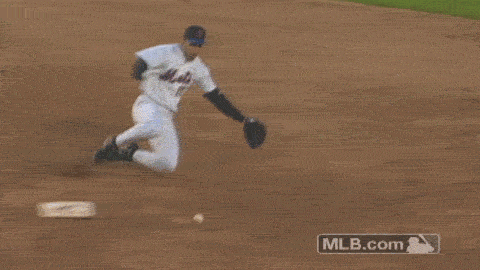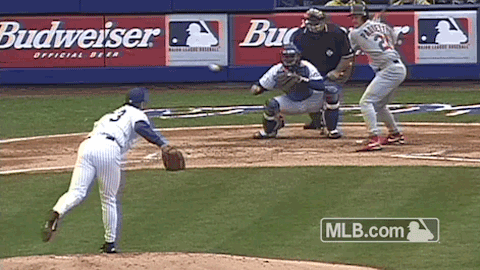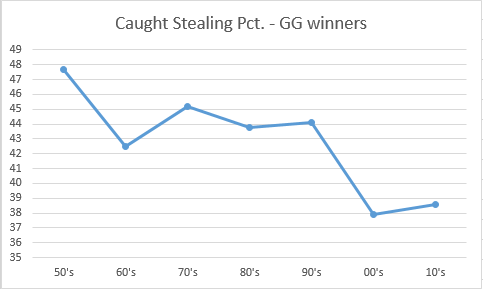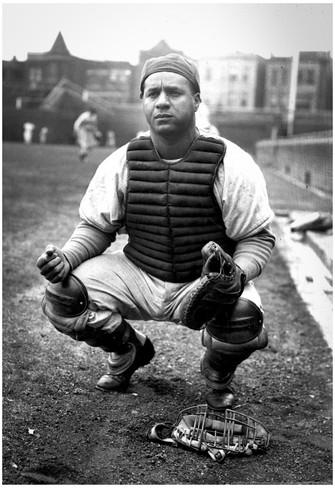Lately, the speed of baseball games has dominated conversation. From Commissioner Manfred to Joe Barstool, everybody has an opinion on how long it seems to take to complete 9 innings of ball and what should be done to remedy the situation. Often times, the slowness of a game was primarily due to players stepping out of the box for excessive amounts of time, adjusting their batting gloves, helmet, belt, you name it, before stepping back in. The pitcher, feeling as if he was being made to wait by the batter, and not wanting to let the batter feel like he was dictating the place of play, would then step off the rubber, adjust his cap, give the rosin bag a few squeezes and take a deep breath before again toeing the rubber. Scenes like this play out hundreds of times every year, essentially grinding the game to a halt. Two Alpha males, puffing their chests out and waving their antlers in the air, wasting everyone’s time. The only reason fans tolerated this pointless gesturing and one-upmanship was because we knew something exciting was about to happen. Who can forget Brett Butler and his amazing drag bunts? He’d lay down a gem at the last possible second – a slow rolling line hugger, perfectly weighted so as to stop just short of the charging fielder. Now lead-off men are about as likely to lay down a drag bunt as they are to star in an action movie with Jesse “The Body” Ventura in the off-season.
And what about Rickey Henderson? Once on base, everyone watched with great anticipation as to what he might do. Coiled like a spring, daring the pitcher to throw over. Eventually he has to go to the plate, right? Will Rickey go first pitch? Suddenly it’s 2-0, will they hit and run? He could score from first on a single if they do. Even pitches where nothing happened were exciting. They were exciting because of what might happen. Now it seems nothing happens, ever.
There’s no denying it; baseball is a slow burn, but I assure you traditionalists have no problem with that. However, the 8-10 seconds of edge-of-your-seat-excitement once enjoyed by fans has been replaced by 8-10 seconds of an overweight guy trotting down to first, only to be followed up by him taking a 2 foot lead-off. Occasionally, that same overweight guy will crush a homerun and fans can watch him slowly jog in a circle for 30 seconds. While everyone loves to see some dude called, ‘Big Daddy’, ‘Big Papi’, or ‘Big Donkey’ (basically anybody who’s called ‘Big’) hammer a potato into the upper deck, many fans pine for the good old days of squeeze bunts, double steals and hit & runs. Those plays were what made the game exciting. Ask any New Englandah about their most memorable play in BoSox history and, as my old buddy Steve will confirm, most list Dave Roberts’ stolen base in the top spot. Notice how I didn’t need to specify which of the seven stolen bases Roberts had as a Red Sock that I’m referring to? It’s because we all remember that stolen base. Why? Because that play was about as exciting as baseball gets. Add that to the ensuing rally, the comeback and series win and, oh boy, have we got some excitement!
With this in mind, I started trying to come up with some minor changes that MLB could make which would, A) make baseball exciting again, and B) avoid excessively altering the way the game is played (the automatic intentional walk rule is a good example). I now present to you, my top five ideas for bringing the excitement back to baseball.
Suggestion #1: Draw a line from home plate, through second base, to the centerfield wall. The fielding team can only have three players positioned on the hitter’s pull side prior to the ball crossing home plate.
What this does: It kills the ridiculous shifts that many original supporters have now come to hate (me included). You can still play your shortstop right behind the bag if you really want to, but gone are the days of him playing second base while the second baseman is out playing shallow right field. First basemen will have to become more mobile which could deter some teams from just plunking down a husky masher and hoping for the best. It also means that second basemen may need to increase their range, thus cutting down on the amount of second-sackers who regularly hit 20+ bombs. Basically, I want to see a few more Don Mattinglys and Dustin Pedroias, and a few less Billy Butlers and Jeff Kents. You’ll never find the next Rey Ordonez if all you care about is power. Case in point: Marcus Semien and his 27 homeruns last year, which went nicely with his .971 fielding percentage and 21 errors (tied for 1st, but still an improvement over the 35 errors he made in 2015).

This is sick and you know it.

Told ya, sick.
It also forces the centre fielder to play every hitter straight away, presumably just a step to the off-field side of our new centre line. This in turn forces the right fielder to either play in the middle of the vast expanse that is right field and right-centre, or shade the line and give the hitter a larger gap to swing for.
Remember when every right fielder had an absolute cannon? We used to see guys like Jay Buhner, Raul Mondesi and Larry Walker regularly gun down base runners attempting to take that extra base. Now it’s often just another masher out there, whichever one is the least-bad at playing outfield (the worst one is presumably DH’ing). This is partly a result of an increased emphasis on hitting – with arm strength (and defence in general) falling by the wayside in favour of having another slugger in the line-up – and party due to the fact that everyone is trying to go yard anyway. So it no longer matters if your right fielder isn’t any good at playing right field, particularly because any mug can camp under a towering fly ball, just as easily as he can watch it sail over the fence.
In response to the added acreage, hitters may abandon the “all or nothing” approach thus creating more doubles and triples, as well as outfielders throwing guys out trying to take those extra bases.
Suggestion #2: Make the bases 10% bigger (as in, wider, not higher).
What this does: This will give baserunners a bigger target and should enable them to sneak a hand in more often on close plays. What it won’t do is make any real difference in how the game is actually played. I’m not talking about making the bases the size of couch cushions, just an inch or so wider each way. The infielder can no longer just lay his glove in front of the bag and wait for the runner to slide into it. Runners can slide in with both hands, and try to pull one away while simultaneously slipping the other one in, in an attempt to dodge the fielder’s tag. Again, this will only have an effect on close plays, making them more exciting. Home plate (and possibly first base) would remain the same.
Suggestion #3: Reduce the active roster to 24.
What this does: If teams chose to dump a hurler (presumably a reliever), they’ll have one less gasser out there to come in and fire aspirins for an inning before the real Closer comes out. Remember when starters regularly worked deep into games? Me neither. Well my dad says they used to pitch seven, sometimes even eight innings. Apparently, some guys even threw nine on occasion. I know, I didn’t believe him either until I looked it up. Turns out, its true! Nowadays, starters throw five or six innings, and are then replaced by wild fire-baller after wild fire-baller until the game is over. Bo-ring.

“A 3 2/3 inning save opportunity? No problem, Skip.”
A team having one less arm in its bullpen won’t really make that much of a difference but it will force managers to actually use their brains when making pitching changes (which they’ll make fewer of), rather than just sauntering out to the mound and calling for whichever cheese-merchant hasn’t thrown in a day or two. I suppose they could send tired arms down and call fresh arms up from the farm every day, but that will burn up those players’ options quicker and probably just annoy the hell out of everyone. And what about LOOGY’s??? Maybe they’ll be forced to throw to not one, but TWO batters… or more! Oh the insanity!!!
It also means that during drawn out, extra inning affairs, teams could run out of pitchers and throw a position player out on the bump. One of my fondest memories was of watching the Rockies’ veteran catcher, 32 year-old Brent Mayne, toe the rubber during a 12 inning affair against the Braves during the 2000 season. Confined to the bench with a sprained wrist, Mayne and his 83 mph “fastball” were called upon in the top of the 12th to shut down the Mighty Turner-ites. Mayne, whose left hand/wrist was so badly swollen he could barely get his (or more likely someone else’s) glove on, gave up a walk, a hit and a wild pitch on his way to collecting his first and only big-league win. In that same game, to lead off that same inning in fact, Tom Glavine was called on to pinch-hit for Scott Kamieniecki. Unfortunately for Mr. Glavine, chicks do not dig the ground-out. A catcher pinch-pitching for a pitcher? A pitcher pinch-hitting for another pitcher?! Who says baseball is boring?!?!
If teams decide to drop a hitter, it increases the likelihood of teams having one of those mystical creatures known as ‘utility guys’ on their roster. Hitting is often sacrificed in favour of a guy who can play pretty much anywhere on the diamond and perform reasonably well defensively – guys like Craig Grebeck, Steve ‘Psycho’ Lyons and my personal favourite, John McDonald. They all fit a similar mold; under six feet tall, kind of wiry, and a gear bag with 3-5 different baseball gloves stuffed into it. One minute he’s wandering around the dugout in a hoodie, then he’s cramming a two-eared helmet on his head and pinch-running for your slow-footed right fielder. He spends two innings in right before a lefty/righty match-up forces the Skipper to pinch hit for the third baseman. The following inning he’s down at the hot corner chatting to the third base coach and crow-hopping throws over to first. You look up an inning and a half later and, for some reason, he’s catching. It’s exciting stuff and entertaining for the fans. Sadly, only Brock Holt seems to carry the torch today.
(Honourable mention goes to Will Ferrell)
Suggestion #4: Get rid of the DH.
You know what makes monster homeruns so exciting? Not seeing them very often.
You ever watch the All-Star game homerun derby? It’s awesome, right? Yeah, right up until the 3rd guy steps up. Then it’s “Huh? Who’s up? Griffey? Oh OK… Oh he’s wearing his hat backwards!!! Hey, didn’t he win it last year? I can’t remember…. I love Chris Berman, what is that shirt he was wearing the other day? Crazy! He must have just gotten back from Hawaii. Yeah I went to Hawaii once, milk cost $24.00 a gallon. Seriously, I think they have to fly it in like every day. Huh? Oh, Griffey is done? Already? How many did he hit? 11? OK cool.”
Yeah, it’s edge of your seat stuff.
I know you AL fans out there will scoff at the incredulity of that statement, before referring to all the exciting homeruns your DH’s have hit over the past decades. In case you’re just joining us, homeruns are part of the problem.
What this does: Losing the DH will force managers to actually manage their teams again, as they now have to deal with having a pitcher (read: quasi-guaranteed out) in the batting order. Bunting, small ball and manufacturing runs, at least in the bottom half of the order, will enjoy a renaissance. Perhaps we’ll see more exciting players like Japanese Phenom Shohei Otani emerge to fill the void left by these departing sluggers.
Suggestion #5: My final suggestion is by far the most outlandish and is the only one that would actually change the way baseball is played rule-wise. As a way to remedy the over-reliance on power in baseball these days, I tried to think of a way to encourage teams to start stealing bases again (remember that super exciting play involving Dave Roberts from earlier?) Here’s what I came up with; steal second, get third for free (if unoccupied).
What this does: Teams will be forced to drastically overhaul their rosters. Attempting to steal bases will immediately become advantageous again. The reward will statistically out-weigh the risk, and Sabermetrics will confirm this. It’s essentially two for the price of one. Every team will need a handful of players who are bona fide base stealing threats, with perhaps another stashed on the bench, the way Roberts was. Baseball will become exciting again.
Power hitting catchers with mediocre arms will be scrapped in favour of catchers who can actually throw the ball to second base. For all the recent attention pitch framing is getting, catchers are actually losing some of their traditional catching skills, like throwing. Miguel Montero recently made headlines for criticizing Jake Arietta after the duo surrendered seven stolen bases in four innings. Montero basically said that Arietta was taking too long to deliver the ball thus giving Montero less time to get the ball down to second. He also made a comment about Cubs pitchers not holding anybody on. In response, the Cubs cut Montero.
As far as holding guys on, Montero may have a point. Nobody steals anymore so, whether they realize it or not, pitchers are probably giving baserunners less attention. When someone does take off, it’s not unlikely that the pitcher wasn’t watching him that closely. It certainly has nothing to do with velocity as we all know pitchers throw harder these days than they have in the past. Montero threw out 29.8% when he was in Arizona, and just 11.3% with the Cubs, so while he may be declining with age, he may also be on to something.
The highest ranked active catcher in caught stealing percentage is Yadier Molina at 41.2%. That’s good enough for 192nd on the all-time list. It’s also, somehow, good enough to win Yadi eight gold gloves. During his gold glove seasons, his highest tally was a respectable 49% (aged 27 – led league). Compare that to Roy Campanella, who gunned down an almost unbelievable 69% of would-be thieves in 1951 (aged 29 – led league). Sadly for Campy, the Gold Glove award wasn’t introduced until 1957, his last season in the Bigs.
I looked at all Gold Glove winning catchers, their average CS% being 42%. There is however a clear downward trend in CS%, among Gold Glove winners anyway.

Figure 1 – Caught stealing percentage (CS%) for AL and NL Gold Glove Winners. Note: 50’s data is from ’57 – ’59 only as GG awards created in 1957.
So while everything in baseball seems to get better – pitchers throw harder, batters hit balls farther – catcher’s throwing abilities are clearly getting worse. Remember, these are the Gold Glovers we’re looking at here, not some jobber shuttling between AAA and the Show. There’s also a lot less stealing these days so it’s not as if their arms are worn out.
Back to Yadi for a second, yes, he’s the top ranked active catcher in CS% but, out of the top 400 of all time, just eight are active players – and three of them are behind Sy Sutcliffe… who was left-handed.

Campy led the league in CS% from 1948-52, gunning down an average of 64%.
BONUS SUGGESTION: Runners thrown out trying to steal are out, but do not count toward the hitting team’s out total. So they lose their base runner, but aren’t charged with an out.
What this does: It’s possible that a small change like this may somehow make stealing bases appealing to teams again. The hitting team gets the chance to advance their runner into scoring position, and the fielding team gets the chance to erase a base runner who otherwise would probably just stand on 1st, waiting for one of his buddies to go yard.
NOTE: This would NOT be used in conjunction with the whole “steal second, get third for free” thing, so calm down.
I know there are a bunch of sabermetric nerds reading this, furiously typing snarky replies as steam whistles out of their ears. They’re busy looking up Rey Ordonez’s bWAR, reliever spin rates and who hit the most 9th inning doubles in the month of August. I get it – the only thing baseball teams care about is winning, and rightly so. I’m not saying teams shouldn’t try to win games. What I am saying is that baseball, in its current form, is often mind-numbingly boring to watch.
As much as I love Moneyball and all (most) of the new theories it spawned, we can’t lose sight of why we all fell in love with baseball in the first place. Today homeruns, walks and strikeouts dominate the game. Sure, players get to run the bases after they walk, but no one does that anymore either. Due to the high value placed on homers these days, strikeouts have become nothing more than an acceptable form of collateral damage as players continue to see who can hit the ball the farthest. That’s not baseball, that’s homerun derby.
At the end of the day, Major League Baseball is a product, a product that Commissioner Manfred needs people to buy. Seriously Rob, Baseball is slow enough on a good day, it’s time to re-inject some excitement into it.


